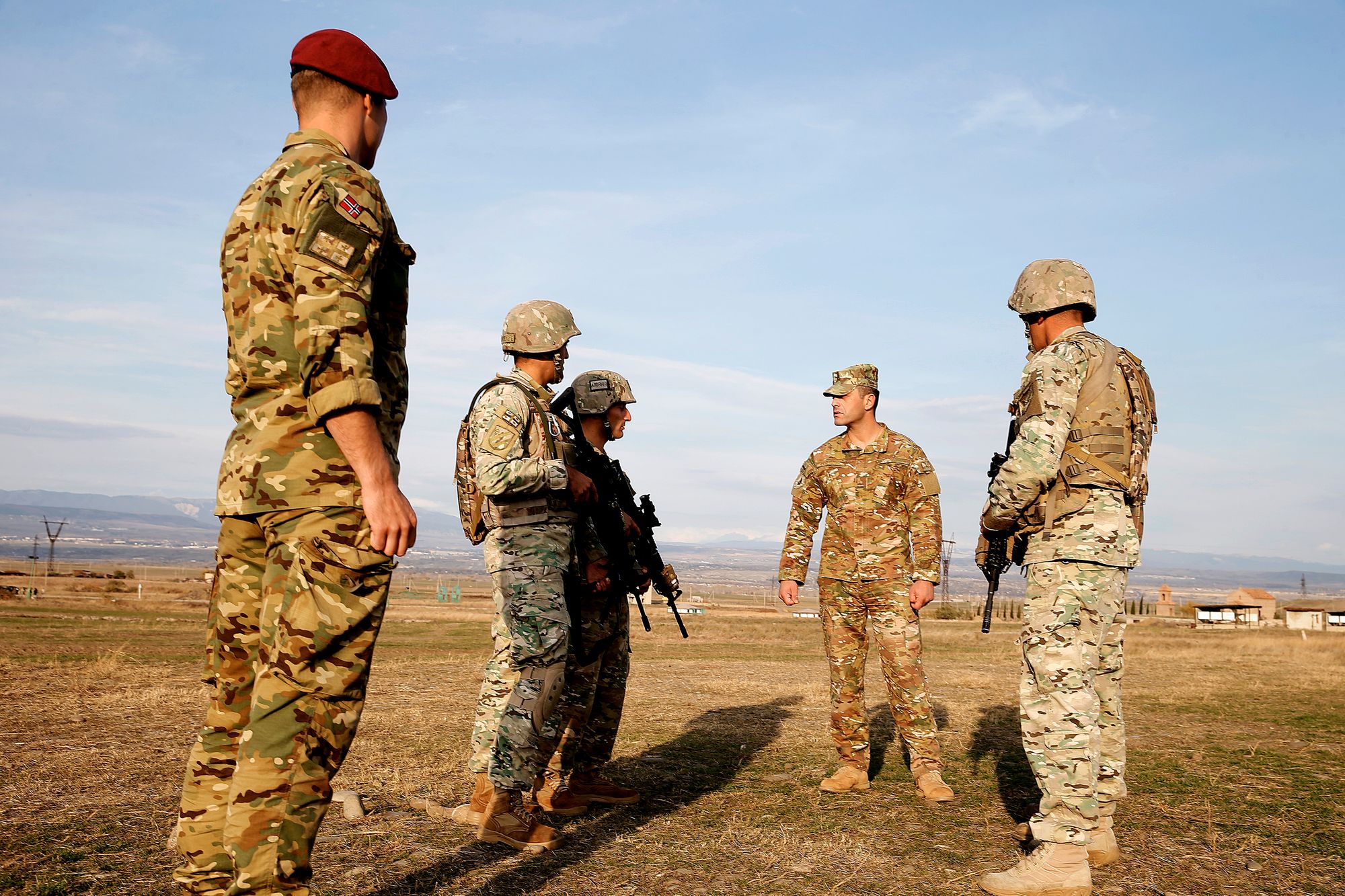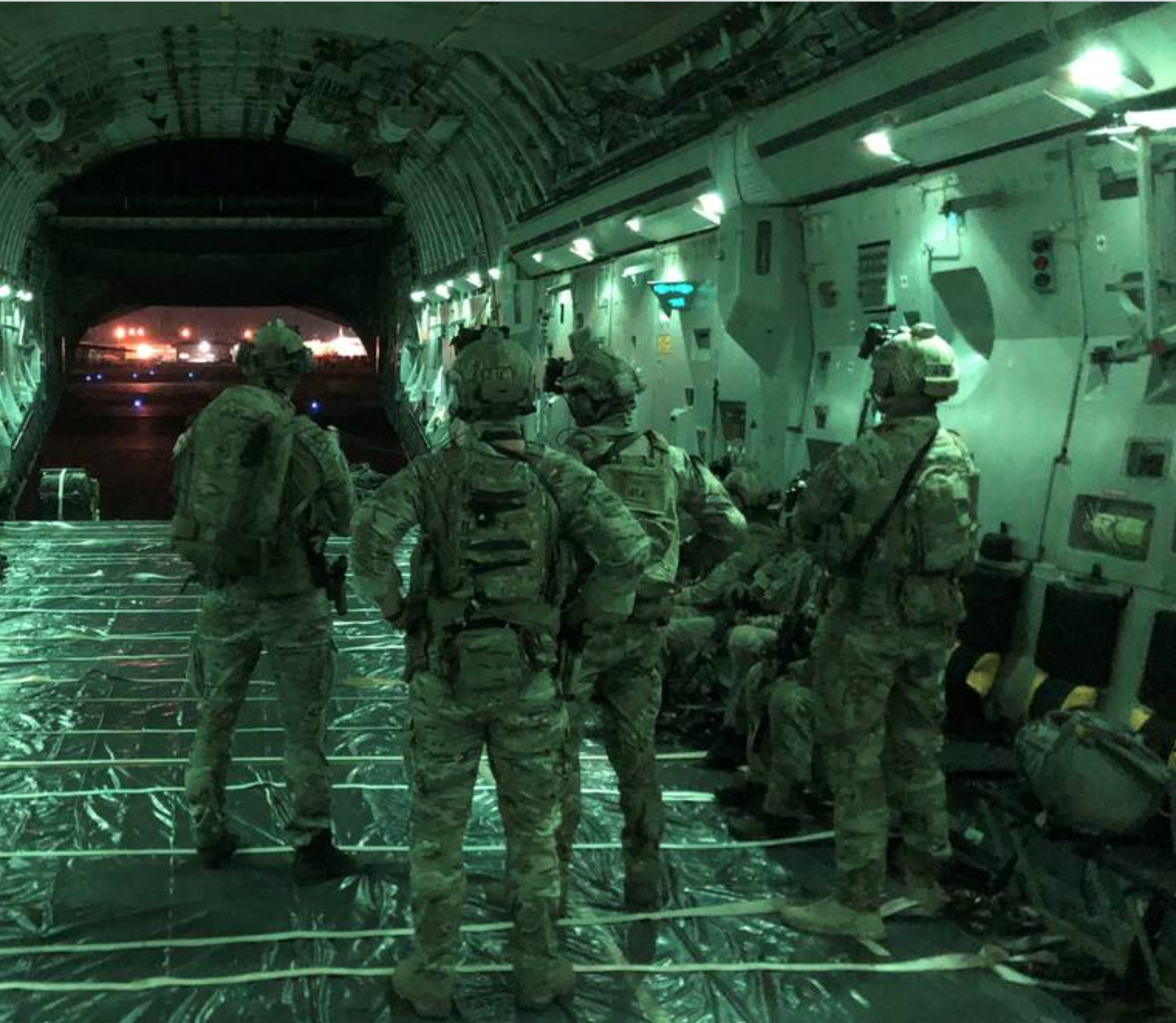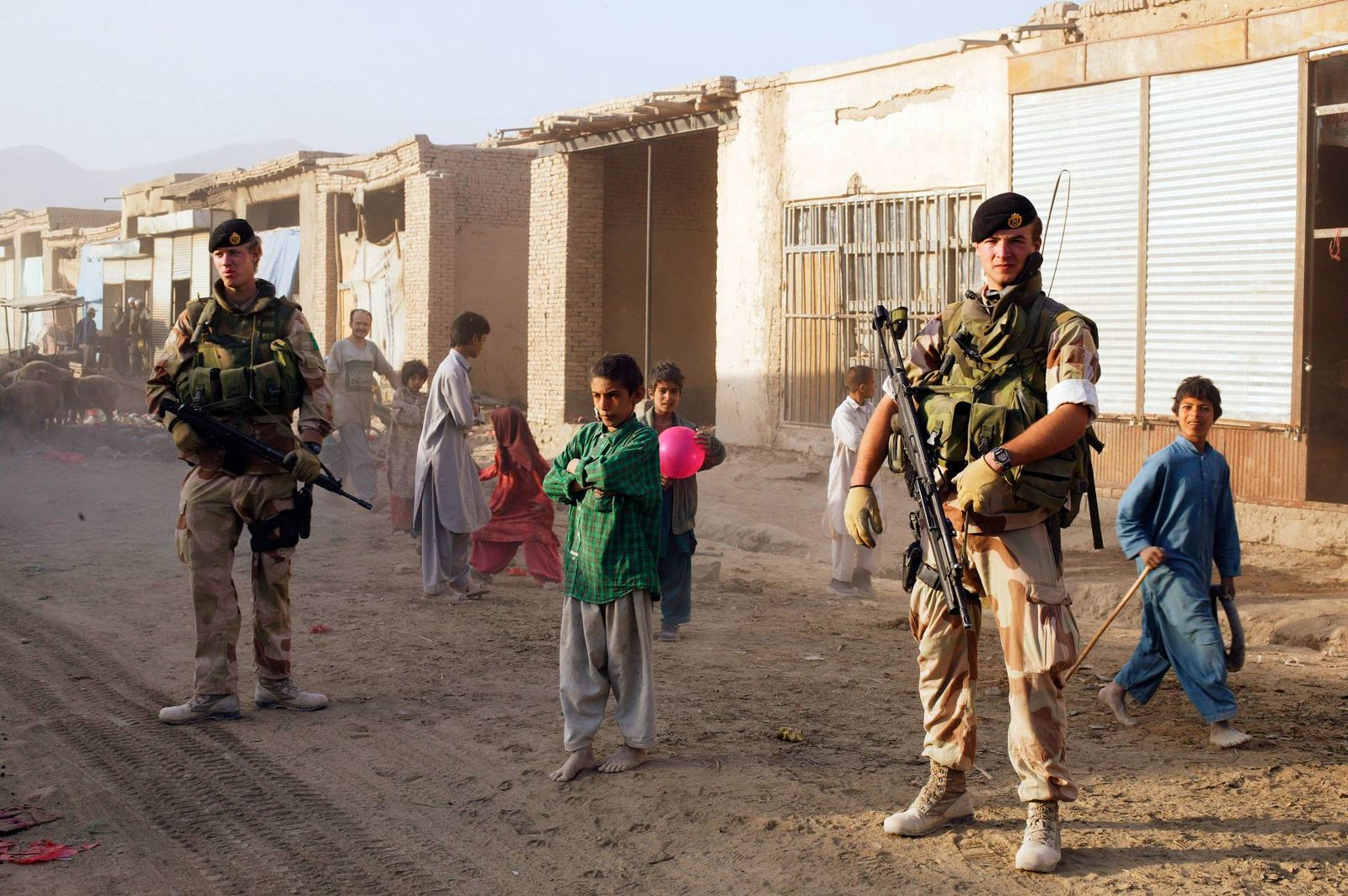Dette er del én av en to-delt artikkel.
Introduction
It is no secret that special operations forces (SOF) and the use of these forces historically has been, currently is, and in the future most likely will continue to be a hot topic of discussion. Academics, military officers, and other representatives from the international security community have put forward theories and principles for how to use SOF (Gray, 2015; Hammersmark, 2010; Johansen, 2015; Kiras, 2006; McRaven, 1996, 2004; Robinson, 2013; Rothstein, 2007; Spulak, 2009; Tucker & Lamb, 2007; Simons 2004, 2012, 2017; Westberg, 2016).
Norwegian officer John Inge Hammersmark (2010) summed up the overarching debate on SOF quite elegantly when he stated, “The field special operations forces may be challenging to deal with since there is actually no generally accepted definition of what special operations are" (p. 10). Nevertheless, at least two principles do seem to be universal, these are: that SOF is a military tool used by decision-makers and intended to produce strategic effects; and, that SOF is intended to solve missions that conventional forces are not trained, equipped or organized to solve. This is what makes SOF strategically effective (McRaven, 2004). The former commander of the Norwegian Special Operations Command (NORSOCOM), Rear Admiral Nils Johan Holte, expressed this explicitly in his speech to Oslo Militaere Samfunn (“Oslo Military Community”) shortly after he was appointed commander for the newly stood up NORSOCOM in 2014 when he stated that "SOF is according to doctrine strategic forces, intended to produce strategic effects", and "SOF is all in all not like conventional forces, SOF shall solve missions that conventional forces are not equipped or trained to solve." (Oslo Militaere Samfunn, 2014).
Even so, national strategic interests differ from country to country because different nations focus on producing different capabilities within their respective militaries, including SOF. As a result, SOF from different nations has different capabilities and specialties. If, from a NATO perspective, the different capabilities are not complementary, NATO could face a severe challenge in the future. Potentially, NATO as a whole will not be able to address the challenges the future presents to the alliance at the given time.
This is important to be aware of, because, according to Frank G. Hoffman (2009), the current security environment is more complex than that of the past. Today’s militaries encounter asymmetric conflicts of unconventional, irregular, hybrid, and sometimes, conventional character. The complexity that the environment represents makes it challenging, and potentially impossible, to see the whole picture, to understand which effects different actions will lead to, and to coordinate and command the needed efforts in a relevant manner (Simons 2017). Nevertheless, this is not to say that we should not try. McChrystal, Collins, Silverman, and Fussell (2015) described a model in their book Team of Teams that lays out how to meet these challenges in the current and the future environment by establishing a Team of Teams. But since the security environment changes so quickly, many nations find it impossible to prepare for all complex contingencies.
Due to differing understanding of definitions of SOF, varying strategic national interests, and differing capabilities within SOF in NATO, nations can enhance their strategic utility by using SOF in new and innovative ways to accommodate the ever-changing security environment. If used correctly, it is possible for small nations to “punch above their own weight” in the international arena by using SOF. As Anna Simons (2017) put it, if a nation “capitalize[s] on its core strengths and unique capabilities” (p. 183), it can “make itself indispensably useful to its global SOF, and NATO partners." (p. 183).
NATO Special Operations Headquarters (NSHQ) has described a requirement for more cost-effective military assistance (MA) operations directed at key strategic objectives (Domrose, 2015; Webb, 2015). NATO SOF and the Global Special Operations Forces Network (GSN) at large acknowledge that different actors can complement each other and can help to collectively address the total challenge the security environment represents (Webb, 2015). The expansion of SOF reach and utility, which these trusted networks could represent for small states, is important (Kristoffersen, 2015). One reason for this is that the GSN can provide the policy level with an alternative security cooperation forum that would have access to information and resources that it would not have without being a member of this network (Kihl & Carling, 2015).
SOF leadership can both contribute to fulfill NATO’s security objectives and educate and encourage decision-makers on the smart use of SOF. One way to do this is to “recommend operations in support of policy, and influence policy by identifying opportunities in sync with vital security interests,” also called “policy by concept of operations” (Berg-Knutsen & Roberts, 2015, p. 71). The aim of this article is to develop MA concepts of operations in support of security policy objectives and propose feasible new concepts for future NATO SOF MA operations.
Several of these ideas are explored through the lens of Norwegian security concerns, and Norway as a contributor to NATO. (The descriptions of the courses of action proposed here are limited to unclassified material, and should be regarded as “food for thought” rather than fully developed ideas.) The article addresses how Norway, by executing military assistance operations in support of negotiations, defense security sector reforms (DSSRs) and disarmament, demobilization, and reintegration processes (DDRs), can enhance the strategic utility of NATO SOF and Norway’s strategic utility within the NATO alliance, while still supporting specific Norwegian national strategic security objectives.
What is Military Assistance?—Different Opinions and Doctrinal Approaches
Since NATO currently consists of 30 different countries, there are differences in opinions on the best way to fulfill the different nations' wishes, requirements and commitments (NATO, 2017). Even though NATO has its own SOF doctrine, Allied Joint Doctrine for Special Operations (AJP-3.5), there are different interpretations of what it means (NATO, 2013). For example, Military Assistance (MA) is described and defined in a way that—by far—makes it the broadest doctrinal task that NATO SOF conducts. MA is defined as “a broad category of measures and activities that support and influence critical friendly assets through organizing training, advising, mentoring, or the conduct of combined operations. The range of MA includes, but is not limited to, capability building of friendly security forces, engagement with local, regional, and national leadership or organizations, and civic actions supporting and influencing the local population. SOF conduct MA within their field of expertise” (NATO, 2013, 2-1).
From our point of view, MA represents the doctrinal task that is most open to interpretation. The other doctrinal tasks, special reconnaissance (SR)[1]and direct action (DA),[2]are, from our point of view, more concrete, but different interpretations still exist. When it comes to MA, there are numerous ways to conduct these types operations. That being said, for an MA operation to be effective, the advising SOF must be competent within a specific field of expertise. As Hickey and Davison (1965) put it in The American Military Advisor and His Foreign Counterpart: The Case of Vietnam, “the first qualification for anyone serving in an intercultural context is professional competence; linguistic and social skills do not make up for lack of professional and technical know-how” (p. 73).
Often, competencies within SR and DA are what are demanded in order to be an effective advisor, but that will not cover all aspects of what MA can involve if one thinks innovatively and 'outside the box' (Kristiansen & Hedenstrom, 2016). But, we believe to be able to think intentionally and intelligently 'outside the box', it is important that you know what is 'inside the box'. That is why nurturing other fields of expertise, in combination with specific national strategic objectives, might open up opportunities for new types of MA operations directed toward other areas of the security sector compared to historical MA operations.
Strategic National Objectives—Norway
National strategies involve some kind of strategic national objectives, even though some of these interests may not appear as strategic outside of the specific nation involved. From our point of view, and based on what can be gleaned from stated Norwegian policy, Norway does not have a particularly clear individual strategy that states strategic national objectives and/or involves large parts of the world. Sometimes this represents a challenge for Norwegian policy-makers, the military, and decision-makers, while on other occasions it represents opportunity.
Norwegian foreign policy and security policy (along that of with Norway’s allies) are currently in flux. (The U.S. military is striving for its Pacific shift; Russia is trying to weaken NATO at several fronts; Donald Trump is still president of the U.S.A; and, the European Union (EU) project is more fragile than ever. ) Indeed, in these turbulent times, the Norwegian Ministry of Foreign Affairs (2016) has launched Project Veivalg (“Path”) to produce what will be only the third government white paper on Norwegian foreign policy in 28 years. Obviously, Norwegian foreign policy has been characterized by continuity, but given events in Europe and beyond, modifications are expected in the near future.
However, three possible national strategic objectives may emerge, when considered from a historical perspective. The two first objectives might be said to be of critical importance, since these are not likely to change in the foreseeable future for obvious geographic and geopolitical reasons.
First, deterrence of Russia is an objective of national strategic interest. This has led to a clear trend of focusing more on national tasks for the Norwegian military, and especially for NORSOF, over the last decade. According to the 2015 Expert Commission on Norwegian Security and Defence Policy, “Russia will remain the defining factor of Norwegian defense planning in the foreseeable future.” (p.5) Beadle and Diesen (2015) likewise argued that Norway will have to take greater responsibility for deterring outside aggression. “This is not a result of fundamental changes in the relationship with Russia, or because the world is likely to become less peaceful. It is mainly caused by growing uncertainty surrounding allied support to Norway in the most likely crisis scenarios” (Beadle & Diesen, p. 4).
Second, maintaining a good and reassuring relationship with Russia is another objective of national strategic interest. Historically, Norway’s relations with Russia have consisted of a delicate balance of deterrence through NATO membership and reassurance through self-imposed military and nuclear restraints, diplomacy, and cooperation whenever possible. Reassurance might be described as Norway’s strategic niche because, before the Baltic countries became members of NATO, Norway was the only NATO country that bordered Russia. General Philip Breedlove (former Supreme Allied Commander Europe [SACEUR]) described Norway’s strategic role this way: “In NATO, we see Norway’s leadership in the way it handles relations with Russia. Norway has a long history of working with Russia in the border areas. You have experiences that we can learn from in NATO” (Langved, 2016).
Third, maintaining a good relationship with international institutions and collective security organizations is an objective in itself. Fulfilling this objective, which mainly involves being a good ally, results in a political demand to support international institutions, like the United Nations (UN), and collective security organizations, such as NATO and the Organization for Security and Cooperation in Europe (OSCE), with expeditionary military capabilities. One outcome affecting the Norwegian military, and especially NORSOF, is an increased demand for different types of MA operations. In 2016, then-U.S. president Barack Obama and NATO secretary general Jens Stoltenberg described an increased requirement for building local military capacity in the frontline states facing Russia, and in Afghanistan, Iraq, Jordan, Libya, and North Africa, to name just a few (White House, 2016). As Beadle and Diesen (2015) argued, the relevance of using Norwegian military means abroad in a globalized world will increase, regardless of changes in the threats at home. This is not likely to change in the near future, and politicians may be tempted to use NORSOF as an investment in political credibility and status abroad, while addressing threats together with NATO at the threat’s place of origin.
The three different national objectives described above represent different challenges if they are to be fulfilled. In combination with the Norwegian military’s current financial situation, it will be crucial for NORSOF to focus on developing capabilities that produce synergy and represent unique niche capabilities in NATO to avoid future imbalance and overstretching.
NORSOF Expertise, Norwegian Strategic Niches
As pointed out earlier, NATO SOF doctrine prescribes that “SOF conducts MA within their field of expertise.” Defining this field of expertise is, therefore, important for NORSOF in order to identify which Norwegian fields of expertise are aligned with Norwegian security interests and national objectives. This is important because NORSOF MA capability should, as we see it, be used in the future to increase Norwegian strategic net results. The best way to accomplish this is to provide NATO SOF or the GSN with something that no one else can provide. Is that possible for Norway, given its SOF’s expertise?
As of now, NORSOF’s expertise is closely linked to the unique Norwegian environment: think arctic conditions, winter, littorals, and mountainous terrain, as well as Norway’s large merchant fleet, and gas and oil platforms (Berg-Knutsen & Roberts, 2015, pp. 28–29). This expertise is relevant for conducting operations on Norwegian territory and can be classified as a niche capability for NATO. No other SOF is likely to be able to exploit the Norwegian environment as NORSOF, even though other SOF will be capable of operating in the specific environment.
In addition, NORSOF has 30 years of experience providing maritime and other CT support to the national police. When conducting these tasks, NORSOF operates under police mandate and rules of engagement (ROE), and NORSOF personnel are used to working in a joint environment. This represents an expertise not displayed by most SOF. This specific expertise has been evident while NORSOF established, mentored, and assisted a national police counterterrorism unit, the crisis response unit (CRU), in Afghanistan. The same expertise has been on display in NORSOF’s advising of Latvian and Lithuanian SOF and during the counterpiracy Operation Atalanta off the Somali coast, where NORSOF is conducted some maritime MA with the Seychelles coast guard (“EU NAVFOR Somalia,” n.d.).
These examples show that the experience required to conduct NORSOF national CT missions in support of the police provides NORSOF with a solid foundation of military expertise that has proved especially relevant in MA operations. But is this expertise unique in NATO SOF, or within the GSN? Is it a niche capability? The answer is most likely no. It is not fair towards our allies to argue that this is entirely true.
Something else considered to be a Norwegian niche is the Norwegian Human Resource Management (HRM) system. This system makes it possible for the Norwegian military, and NORSOF, to keep non-commissioned officers and officers on active duty until they are 60 years old. This means that a Norwegian military career can stretch out for as long as 38 years (Berg-Knutsen & Roberts, 2015, p. 47). As pointed out in Strategic Design NORSOF 2025, this fact makes it necessary for NORSOF to plan how to use its personnel with a lifelong perspective (Berg-Knutsen & Roberts, 2015, pp. 46–47). Norway has conscription of all members of its population, male and female (Regjeringen, 2014). This conscription model, in combination with the fact that the Norwegian military does not need everyone to serve in order to fill its organization, works as a first line of selection for NORSOF. Since NORSOF selects from a pool of individuals that already have been selected for conscription, the quality of the personnel within NORSOF is high and makes it possible for NORSOF to stand up different career tracks for different types of personnel if NORSOF wants to. The HRM model, as proposed in Strategic Design NORSOF 2025 and depicted in Figures 1 and 2, covers three different tracks—Warrior Diplomat, Subject Matter Expert, and Command—and the proposed model of a networked community of experts working within NORSOF specifically with Military Assistance, as described in a recent capstone project covering NORSOF Military Assistance capability development, may represent a niche if NORSOF puts efforts into establishing them (Berg-Knutsen & Roberts, 2015, pp. 51–55; Kristiansen & Hedenstrom, 2016, pp. 88–89, 91–96).
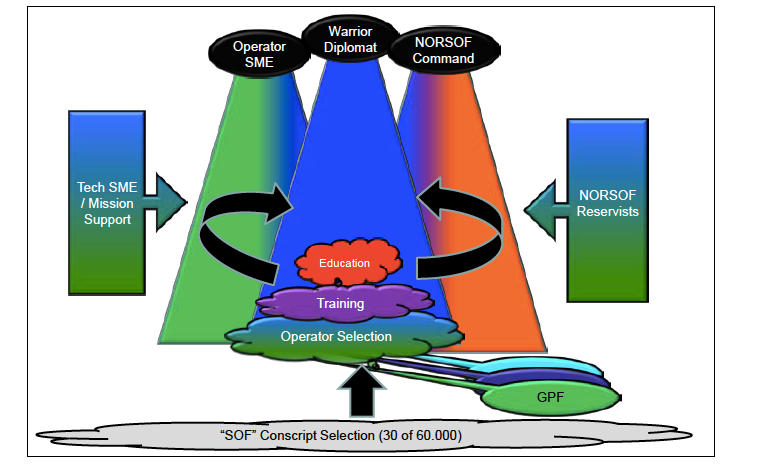
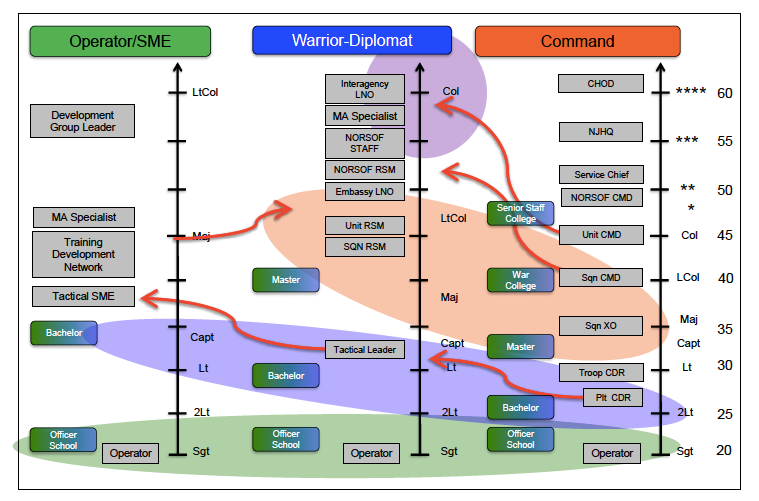
Can Norway as a nation also represent a niche in itself in future MA operations? If so, can NORSOF exploit it in order to produce unique effects on behalf of NATO by doing MA operations? We believe so.
It is often argued that small-state Norway “punches above its weight” in international affairs, especially with regards to conflict resolution. What has made Norway useful and important to the great powers after the Cold War has been its policy of involvement (Carvalho & Lie, 2014, p. 62). Norwegian involvement in a series of negotiation processes is what has given the country stature, standing, and access beyond its size. Since 1993, Norway has been involved in conflict negotiations in South Sudan, Sri Lanka, Somalia, the Philippines, Israel/Palestine, Nepal, Myanmar, Guatemala, Colombia, Afghanistan, and Libya (Norwegian Government, 2013; Norwegian Ministry of Foreign Affairs, 2016).
As pointed out by Haaverstad (2011), Norway has also had substantial success with defense security sector reform (DSSR) projects when the Department of Defense (DOD) and Ministry of Foreign Affairs have worked closely together. For instance, Norway conducted two DSSR projects in the West Balkans, one in Serbia and one in Montenegro. Both were said to enhance stability and development in the Western Balkans, a key Norwegian policy objective at the time (Haaverstad, 2011, p. 5). Norway has also led the interagency establishment of the Joint Training and Evaluation Center (JTEC) in Georgia, which is one of the most important measures taken lately to qualify Georgia for a potential NATO membership (NATO, 2015).
Indeed, Norway is well suited to pursue these types of operations, but should NORSOF focus on these roles? Our conclusion is yes. Arguably, Norway is better positioned than any other country to create strategic effects in conflicts between or within small states, by utilizing diplomatic networks and Norway’s reputation. Norway is a “superpower” when it comes to conflict resolution, with well-developed diplomacy, reputation, financial resources, patience, endurance, and a network for this activity (Hanssen-Bauer, 2005, p. 4). In combination with a small, flexible, well-educated, well-trained, well-equipped, and strategic-thinking NORSOF, which consists of specially selected operators and officers who potentially have lifelong careers within SOF, as described in the Strategic Design NORSOF 2025 and depicted in Figure 3, Norway can represent an important and unique niche capability for NATO and the GSN (Berg-Knutsen & Roberts, 2015, pp. 46–47). This role is in line with what the strategic design study, Strategic Design NORSOF 2025, mentions as relevant roles for NORSOF in the future (see Figure 3; Berg-Knutsen & Roberts, 2015, p. 32).

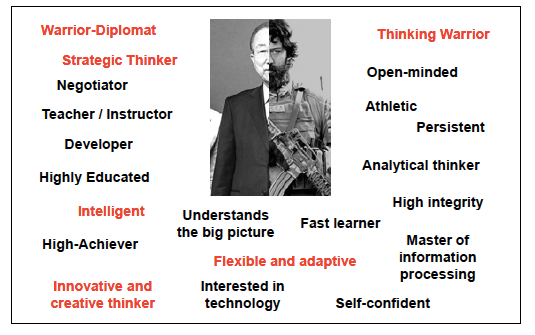
Foto: NORSOF in Georgia, JTEC. Training the trainer (Torbjorn Kjosvold / Forsvaret)
This article has been published in SWJ
[1] SR as defined in NATO (2013): “SR is conducted by SOF to support the collection of a commander's Priority Intelligence Requirements (PIRs) by employing unique capabilities or Joint Intelligence, Surveillance, and Reconnaissance (JISR) assets. As part of the Allied theatre INTEL collection process, SR provides specific, well-defined, and possibly time-sensitive information of strategic or operational significance. It may complement other collection methods where constraints are imposed by weather, terrain-masking, hostile countermeasures, or other systems’ availability. SR places persistent ‘eyes on target’ in hostile, denied, or politically sensitive territory. SOF can provide timely information by using their judgment and initiative in a way that technical JISR cannot. SOF may conduct these tasks separately, supported by, in conjunction with, or in support of other component commands. They may use advanced reconnaissance and surveillance techniques, JISR assets and equipment, and collection methods, sometimes augmented by the employment of indigenous assets.”
[2]DA as defined in NATO (2013): “DA is a precise offensive operation conducted by SOF which is limited in scope and duration in order to seize, destroy, disrupt, capture, exploit, recover, or damage high value or high pay-off targets. DA differs from conventional offensive actions in the level of risk, techniques employed, and the degree of precision utilized to create a specific effect, and usually incorporates a planned withdrawal from the immediate objective area. DA is focused on specific, well-defined targets of strategic and operational significance, or in the conduct of decisive tactical operations. SOF may conduct DA independently, with support from conventional forces, or in support of conventional forces. Activities within DA can include: raids, Ambushes, Assaults, Terminal Guidance Operations, Recovery Operations, Precision Destruction Operations, and Opposed boarding operations” (p. 2-3).
Del to av artikkelserien kan leses her.
Bibliography
Bakkeli, T. (2013). Krigere og Diplomater—På innsiden av Forvarets Spesialkommando [Warriors and diplomats: Inside the Norwegian Special Operations Forces] (1st ed.). Oslo, Norway: Kagge Forlag.
Beadle, A. W., & Diesen, S. (2015). Global trends toward 2040: Implications for the Norwegian Defence Forces’ roles and relevance. Oslo, Norway: FFI. Retrieved from http://www.ffi.no/no/Rapporter/15-01452.pdf
Berg-Knutsen, E., & Roberts, N. (2015). Strategic design for NORSOF 2025. (Technical report). Monterey, CA: Naval Postgraduate School. Retrieved from http://calhoun.nps.edu/bitstream/handle/10945/47444/NPS-DA-15-001.pdf?sequence=1&isAllowed=y
Carvalho, B., & Lie, J. H. S. (2014). A great power performance: Norway, status, and the policy of involvement. In B. Carvalho & I. B. Neumann (Eds.), Small states and status seeking: Norway’s quest for international standing (pp. 56–72). New York, NY: Routledge.
Domrose, H.-L. (2015). COM JFC BS’ NATO SOF Symposium Speech 2015: The Russian hybrid warfare model; Using SOF for “Hybrid Defense.” Mons, Belgium: NSHQ, 2015.
Ege, R. T. (2012, September 1). Here are Norway’s toughest medical doctors. Verdens Gang. Retrieved from http://www.vg.no/nyheter/innenriks/forsvaret/her-er-norges-toeffeste-leger/a/10045344/
EU NAVFOR Somalia. (n.d.). Missions. Retrieved from http://eunavfor.eu/mission/
Expert Commission on Norwegian Security and Defence Policy. (2015). Unified effort. Oslo, Norway: Norwegian Department of Defense.
Fisas, V. (Ed.). (2016). Yearbook of peace processes. Barcelona, Spain: Icaria Editorial.
Gray, C. S. (1999). Modern strategy. Oxford, England: Oxford University Press.
Gray, C. S. (1996). Explorations in strategy. Santa Barbara, CA: Praeger.
Gray, C. S. (2015). Tactical Operations for Strategic Effect: The Challenge of Currency Conversion. Tampa: Joint Special Operations University Press.
Godal, B. T., et al. (2016). A good ally: Norway in Afghanistan 2001–2014. Oslo, Norway: Norwegian Government Administration Services.
Haaverstad, T. (2011). Defense security sector reform: Organization, intentions, and results (Master’s thesis). Norwegian Defense College, Oslo, Norway. Retrieved from https://brage.bibsys.no/xmlui/bitstream/handle/11250/100020/Masteroppgave%20FHS%20-%20Haaverstad%20Terje.pdf?sequence=1
Hammersmark, J. I. (2010). The development of Norwegian Special Forces: Symbolic or functional utility?(Master’s thesis). Forsvarets stabsskole, Oslo, Norway. Retrieved from https://brage.bibsys.no/xmlui/bitstream/handle/11250/99868/Hammersmark,%20John%20Inge.pdf?sequence=1
Hanssen-Bauer, J. (2005, October 28). The Norwegian “model” for conflict resolution [Speech]. Lisbon, Portugal.
Helgesen, V. (2007). How peace diplomacy lost post 9/11: What implications are there for Norway? (Oslo Files on Defence and Security, no. 3). Oslo, Norway: Norwegian Institute for Defence Studies.
Hickey, G. C., & Davison, W. P. (1965). The American military advisor and his foreign counterpart: The case of Vietnam. Santa Monica, CA: RAND Corporation.
Hoffman, F. G. (2009). “Hybrid warfare and challenges.” Joint Force Quarterly, 52(1). Retrieved from http://ndupress.ndu.edu/portals/68/Documents/jfq/jfq-52.pdf
Johansen, I. (2015). Special Operations Forces: A weapon of choice for future operations? In P. M. Norheim-Martinsen & T. Nyhamar (Eds.), International military operations in the 21st century: Global trends and the future of intervention (pp. 97–115). New York, NY: Routledge.
Kihl, T.-E., & Carling, J. (2015). The global Special Operations Forces network from a partner-nation perspective (Capstone report). Naval Postgraduate School, Monterey, CA. Retrieved from http://calhoun.nps.edu/bitstream/handle/10945/44594/14Dec_Kihl_Carling.pdf?sequence=1
Kiras, J. D. (2006). Special operations and strategy: From World War II to the War on Terrorism. London, England: Routledge.
Kristiansen, M., & Hedenstrom, A. (2016). NORSOF military assistance capability development (Master’s capstone project). Naval Postgraduate School, Monterey, CA. Retrieved from http://calhoun.nps.edu/bitstream/handle/10945/50557/16Sep_Hedenstrom_Kristiansen.pdf?sequence=1
Kristoffersen, E. (2015). Small states, smart solutions: Investing in National Joint Special Operations Command[Strategy Research Project]. United States Army War College, Carlisle, PA.
Langved, A. (2016, February 3). Interview with SACEUR General Philip M. Breedlove, titled: “Bakkestyrker Er Nøkkelen Til Suksess” (Ground forces is the key to success). Dagens Næringsliv. Retrieved from http://www.dn.no/nyheter/utenriks/2016/02/02/2144/Politikk/-bakkestyrker-er-nkkelen-til-suksess
Lysberg, M. (2016, January 25). Demanded Gadaffi’s retreat. Klassekampen. Retrieved from http://www.klassekampen.no/article/20160125/ARTICLE/160129928
McChrystal, G. S., Collins, T., Silverman, D., & Fussell, C. (2015). Team of teams: New rules of engagement for a complex world. New York, NY: Penguin.
McRaven, W. H. (1996). Spec ops: Case studies in special operations warfare; Theory and practice. New York, NY: Ballantine Books.
McRaven, W. H (2004), Special Operations: The Perfect Grand Strategy, chapter in: Horn, B., Last, D. M., & Taillon, J. P. D. B. (Eds.). (2004). Force of Choice: Perspectives on Special Operations. Queen's University School of Policy Studies.
Melien, T. J. (2012). Vaare Hemmelige Soldater. Norske Spesialstyrker 1940–2012 [Our secret soldiers: Norwegian Special Operations Forces 1940–2012]. (1st ed., Vol. 1). Oslo, Norway: Spartacus, 2012.
NATO. (2013). Allied joint doctrine for special operations (AJP-3.5, Version A, Edition 1). Brussels, Belgium: NATO Standardization Agency.
NATO. (2015). NATO-Georgian Joint Training and Evaluation Center (JTEC). Retrieved from http://www.nato.int/nato_static_fl2014/assets/pdf/pdf_topics/20150827_150827-jtec-georgia.pdf
NATO. (2017). Member countries. Retrieved from http://www.nato.int/cps/is/natohq/topics_52044.htm
Norwegian Government. (2013, July 26). Norway’s engagement in peace processes since 1993. Retrieved from https://www.regjeringen.no/en/topics/foreign-affairs/peaceandreconciliation-efforts/innsiktsmappe/peace_efforts/id732943/
Norwegian Ministry of Foreign Affairs. (2016, January 27). Choices in Norwegian foreign and security policy. Retrieved from https://www.regjeringen.no/no/tema/utenrikssaker/sikkerhetspolitikk/meldst_veivalg/id2472157/
Oliver, I. (2005). War and peace in the Balkans: The diplomacy of conflict in the former Yugoslavia. London, England: I. B. Tauris.
Oslo Militaere Samfunn. (2014). Kontreadmiral Nils Johan Holte Sjef Forsvarets spesialstyrker, “Manus til Tale i OMS den 31 mars 2014” [RADM Nils Johan Holte, Commander NORSOCOM "Speech for OMS 31 March 2014"]. Retrieved from https://www.oslomilsamfund.no/wp-content/uploads/2017/01/2014-03-31-Holte.pdf
Regjeringen. (2013, October 27). U.S. citizen released in Colombia with Norwegian help. The Norwegian Government. Retrieved from https://goo.gl/QYYiL3
Regjeringen. (2014, November 4). Allmenn Verneplikt [Mandatory conscription]. Retrieved from https://www.regjeringen.no/no/tema/forsvar/innsikt/allmenn-verneplikt/id2009109/
Regjeringen. (2015, July 19). Colombian officer released with Norwegian assistance. The Norwegian Government. Retrieved from https://goo.gl/AqE0ZQ
Robinson, L. (2013). The future of U.S. Special Operations Forces (Council Special Report No. 66). New York, NY: Council on Foreign Relations. Retrieved from https://www.cfr.org/sites/default/files/pdf/2013/03/Special_Operations_CSR66.pdf
Rothstein, H. (2007). Less is more: The problematic future of irregular warfare in an era of collapsing states. Third World Quarterly, 28(2), 275–294.
Royal Norwegian Embassy in Manila. (n.d.). Norwegian envoys share experiences from the peace process in Colombia. Retrieved from http://goo.gl/LNbjvt
Simons, A. (2017). 21st-Century Challenges of Command: A View from the Field, Strategic Studies Institute and U.S. Army War College Press, Carlisle, Pennsylvania. Retrieved from https://ssi.armywarcollege.edu/pubs/display.cfm?pubID=1353
Simons, A. (2012). SOF 2030: An NPS Defense Analysis seminar report, 2011 long term strategy seminar(Monterey, CA: Naval Postgraduate School).
Simons, A. (2017). “Scalpel” or “Easy Button”? Neither–And some further considerations. In G H. Christensen (Ed.), Interdisciplinary Perspectives on Special Operations Forces (pp. 168–188). Copenhagen, Denmark: Royal Danish Defence College. Retrieved from http://fak.dk/publikationer/Documents/Conference%20Proceedings%20No%204%20(a)%202017%20NET.pdf
Sørbø, G., Goodhand, J., Klem, B., Nissen, A. E., & Selbervik, H. (2011). Pawns of peace: Evaluation of Norwegian peace efforts in Sri Lanka,1997–2009. Oslo, Norway: NORAD Evaluation Department. Retrieved from https://goo.gl/WrgqzK
Spulak, R. G. (2009). A theory of special operations: The origin, qualities, and use of SOF. Military Technology, 33 (Special issue), 23–28.
Tucker, D., & Lamb, C. J. (2007). United States Special Operations Forces. New York, NY: Columbia University Press.
United Nations Department of Peacekeeping Operations, Office of Rule of Law and Security Institutions, Disarmament, Demobilization, and Reintegration Section. (2010). Second generation disarmament, demobilization, and reintegration (DDR) practises in peace operations. New York, NY: United Nations, 2010.
UN News Center. (2016, July 20). In Havana, Ban hails Colombia ceasefire pact as example of peace with dignity. Retrieved from http://www.un.org/apps/news/story.asp?NewsID=54312#.V408pI6XHV0
Webb, M. B. (2015). COM NSHQ speech—NSHQ Hybrid Warfare Symposium 2015. Mons, Belgium: NSHQ.
Westberg, A. (2016). In silence towards the unknown: Principles of special reconnaissance and surveillance(Master’s thesis). Naval Postgraduate School, Monterey, CA. http://calhoun.nps.edu/bitstream/handle/10945/49413/16Jun_Westberg_Anders.pdf?sequence=1&isAllowed=y
White House. (2016, April 4). Remarks by the president and Secretary General Stoltenberg of NATO after bilateral meeting. Retrieved from https://www.whitehouse.gov/thepress-office/2016/04/04/remarks-president-and-secretary-general-stoltenberg-nato-after-bilateral


